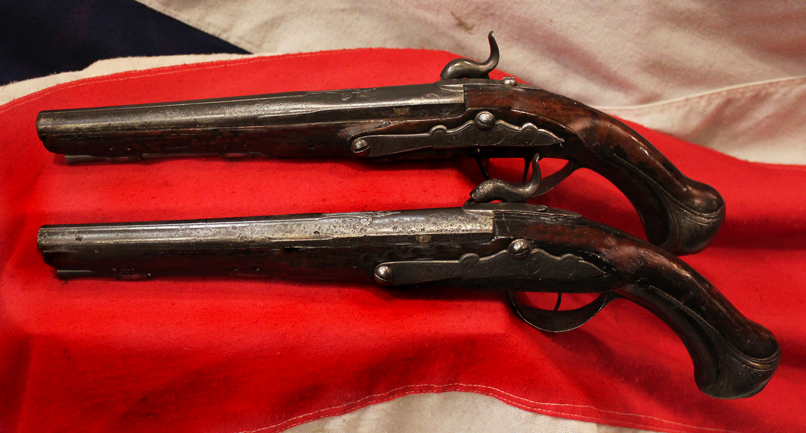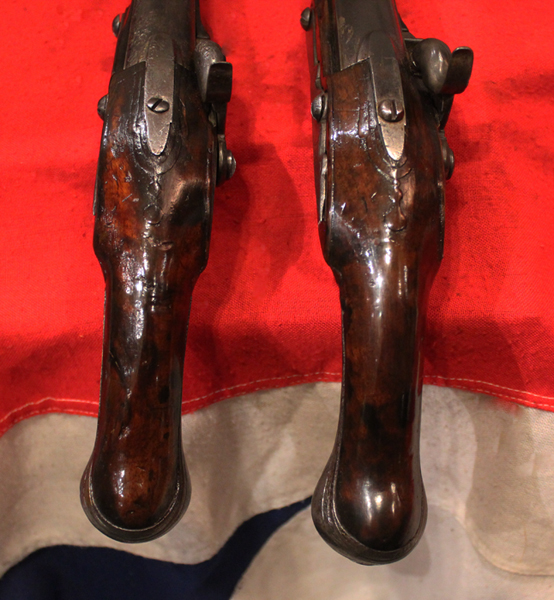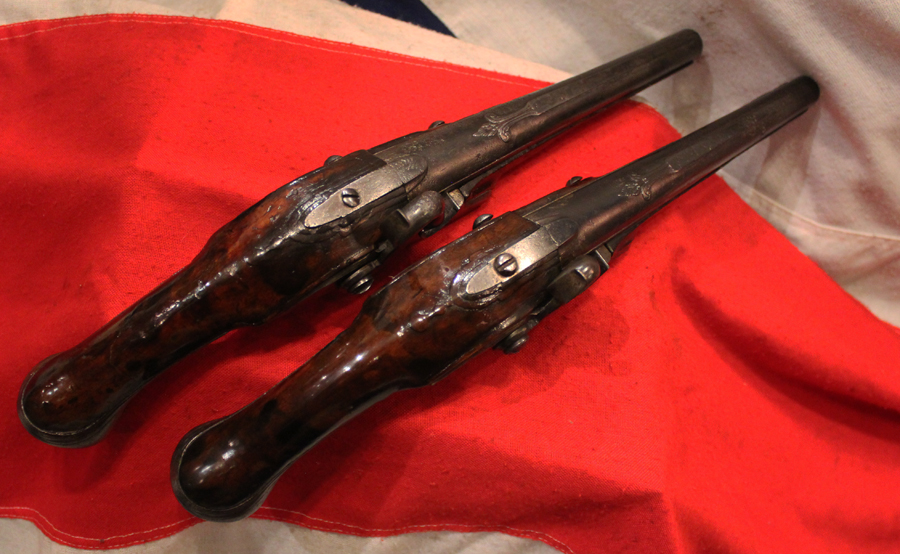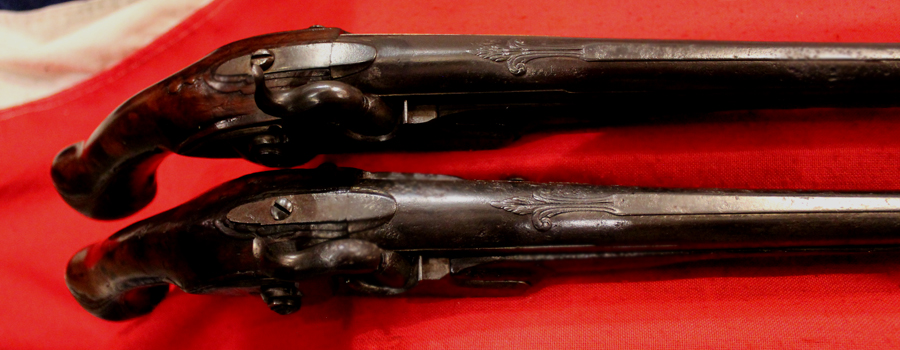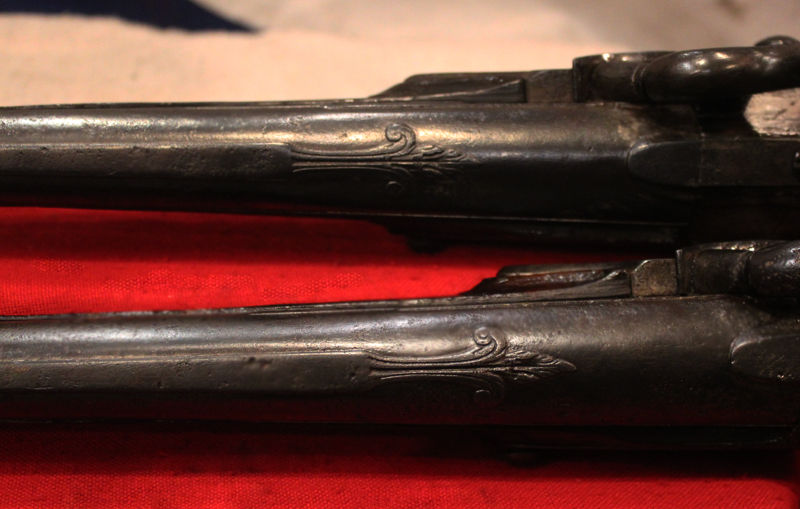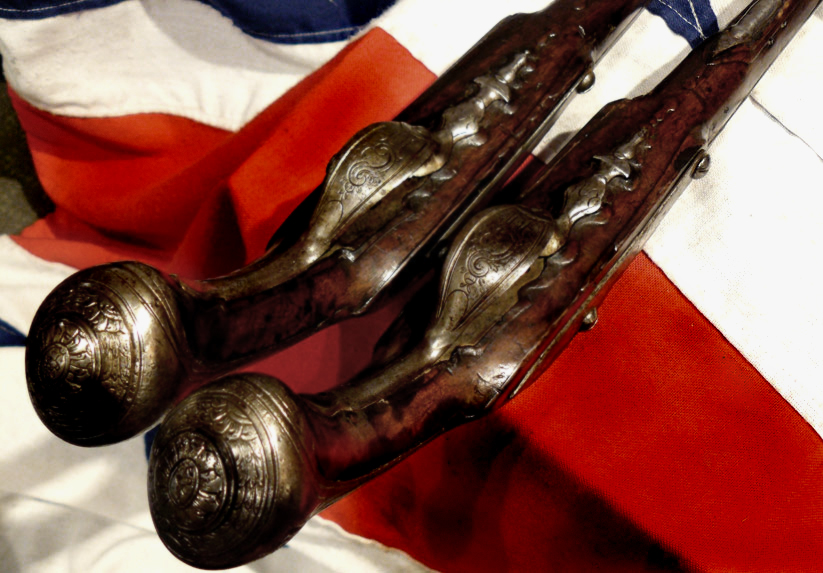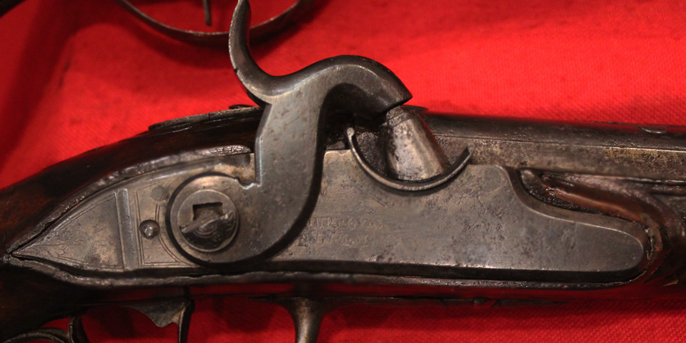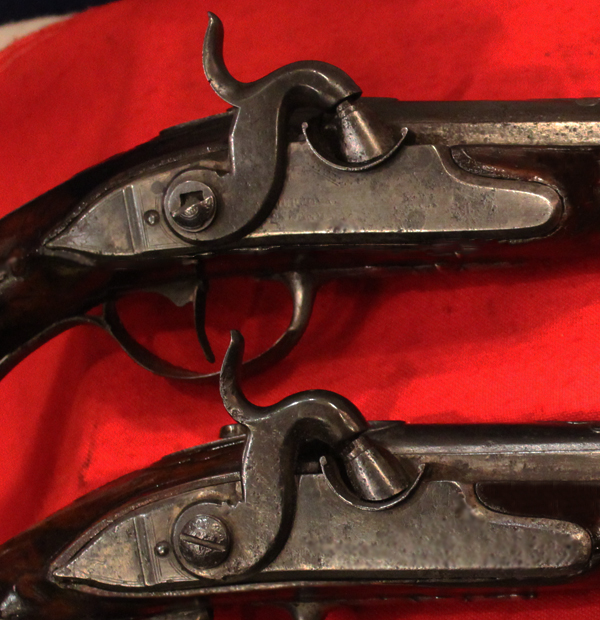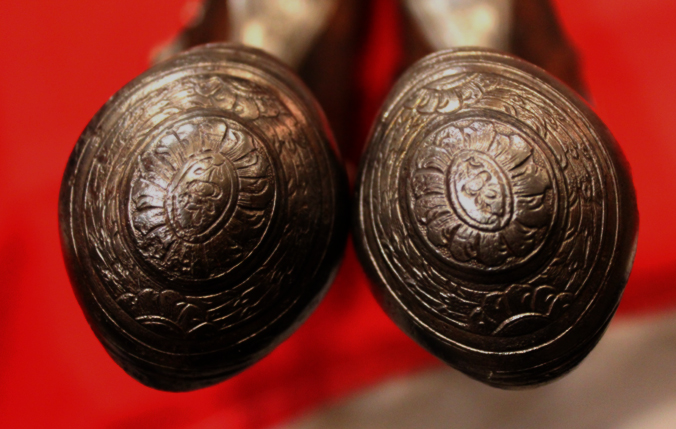A Wonderful & Historical Pair of Mid 18th Century 'Royal' French Long Holster Pistols, Marked 'Cour Royal', 1754 American Anglo-French-Indian War & Revolutionary War of 1776 Period Flintlocks, Circa 1750. Made For An Officer Of the French Royal Court
The walnut has wonderful patina, the steel barrel and mounts are all in the rococco décor form, both hand chisseled and engraved, with overall surface age pitting. Very good tight actions to both. The locks were transform silex almost two hundred years ago, which is an upgrade system to convert the actions to percussion, in order to ensure their working life by an additional forty years or so. Locks engraved Cour Royal with feint makers name beneath. Barrels bear superb gun barrel makers proof stamps. Sadly we know not the name of the officer in Louis XVth’s court for whom they were made, but they were used in the Americas in the 1750’s, and 1770’s and were upgraded likely there too in the early 1800’s. However, being a Royal Court maker he must of been of substantial position, rank, and indeed power, within the King’s army. It is intriguing to wonder who it may have been, possibly one of the French general’s. Such as, Louis-Joseph de Montcalm
Marquis de Vaudreuil
Baron Dieskau
François-Marie de Lignery
The French and Indian War (1754–63) comprised the North American theatre of the worldwide Seven Years' War of 1756–63. It pitted the colonies of British America against those of New France. Both sides were supported by military units from their parent countries of Great Britain and France, as well as by American Indian allies. At the start of the war, the French North American colonies had a population of roughly 60,000 settlers, compared with 2 million in the British North American colonies. The outnumbered French particularly depended on the Indians. The European nations declared war on one another in 1756 following months of localized conflict, escalating the war from a regional affair into an intercontinental conflict.
The name French and Indian War is used mainly in the United States. It refers to the two main enemies of the British colonists: the royal French forces and the various American Indian forces allied with them. The British colonists were supported at various times by the Iroquois, Catawba, and Cherokee, and the French colonists were supported by Wabanaki Confederacy members Abenaki and Mi'kmaq, and Algonquin, Lenape, Ojibwa, Ottawa, Shawnee, and Wyandot.
British and other European historians use the term the Seven Years' War, as do English-speaking Canadians. French Canadians call it La guerre de la Conquête (the War of the Conquest) or (rarely) the Fourth Intercolonial War.
Fighting took place primarily along the frontiers between New France and the British colonies, from Virginia in the south to Newfoundland in the north. It began with a dispute over control of the confluence of the Allegheny and Monongahela rivers called the Forks of the Ohio, and the site of the French Fort Duquesne within present-day Pittsburgh, Pennsylvania. The dispute erupted into violence in the Battle of Jumonville Glen in May 1754, during which Virginia militiamen under the command of 22-year-old George Washington ambushed a French patrol.
In 1755, six colonial governors in North America met with General Edward Braddock, the newly arrived British Army commander, and planned a four-way attack on the French. None succeeded, and the main effort by Braddock proved a disaster; he lost the Battle of the Monongahela on July 9, 1755 and died a few days later. British operations failed in the frontier areas of Pennsylvania and New York during 1755–57 due to a combination of poor management, internal divisions, effective Canadian scouts, French regular forces, and Indian warrior allies. In 1755, the British captured Fort Beauséjour on the border separating Nova Scotia from Acadia, and they ordered the expulsion of the Acadians (1755–64) soon afterwards. Orders for the deportation were given by William Shirley, Commander-in-Chief, North America, without direction from Great Britain. The Acadians were expelled, both those captured in arms and those who had sworn the loyalty oath to His Britannic Majesty. Indians likewise were driven off the land to make way for settlers from New England.
The British colonial government fell in the region of modern Nova Scotia after several disastrous campaigns in 1757, including a failed expedition against Louisbourg and the Siege of Fort William Henry; this last was followed by Indians torturing and massacring their British victims. William Pitt came to power and significantly increased British military resources in the colonies at a time when France was unwilling to risk large convoys to aid the limited forces that they had in New France, preferring to concentrate their forces against Prussia and its allies in the European theater of the war. Between 1758 and 1760, the British military launched a campaign to capture the Colony of Canada (part of New France). They succeeded in capturing territory in surrounding colonies and ultimately the city of Quebec (1759). The British later lost the Battle of Sainte-Foy west of Quebec (1760), but the French ceded Canada in accordance with the Treaty of Paris (1763).
The outcome was one of the most significant developments in a century of Anglo-French conflict. France ceded to Great Britain its territory east of the Mississippi. It ceded French Louisiana west of the Mississippi River (including New Orleans) to its ally Spain in compensation for Spain's loss to Britain of Florida. (Spain had ceded Florida to Britain in exchange for the return of Havana, Cuba.) France's colonial presence north of the Caribbean was reduced to the islands of Saint Pierre and Miquelon, confirming Great Britain's position as the dominant colonial power in eastern North America.
Once the war was concluded just over a decade later these pistols saw service in the American Revolutionary War of the 1770’s, but most likely then by an American officer as they were almost certainly taken as war booty or surrendered during the French Indian War, in order for them to have remained in the Americas until the 18th century at least.
Code: 21241
3750.00 GBP


